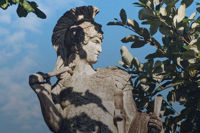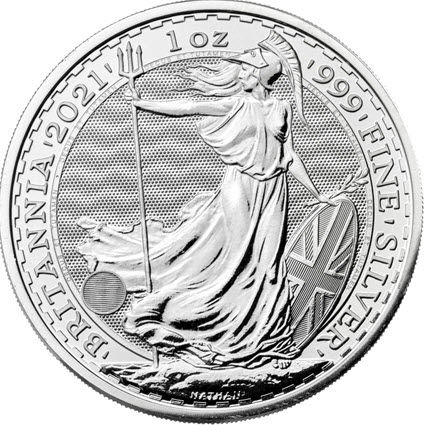Posted on June 02, 2021

By Paul Vanguard, for BullionMax.com
When you look at a coin from the U.K. or its members of the Commonwealth of Nations, the first woman you're likely to see is Her Majesty Queen Elizabeth II. She's been the Queen of the U.K. and Commonwealth since 1953, and though the specific portraits have changed over the years, the Queen has always been on them.
But there's another woman whose image has appeared on English coins for nearly 2,000 years. Her name? Britannia.
The trident-holding female warrior is to the U.K.'s Royal Mint what the bald eagle is to the U.S. Mint: specifically, a personification of the nation. While the British might not get to see their cultural icon as often as we do ours, the Royal Mint has definitely put its work in when it comes to designing and issuing Britannia coins. Even when the Royal Mint retired Britannia from circulating-coin designs in 2008, it nonetheless chose to keep her on the gold and silver bullion and proof coins.
Likewise, while the American silver eagle obverse design has stuck around for 35 years and is just now being changed, the silver Britannia coin tends to undergo regular, drastic changes. Different artists contribute entirely different designs on an almost annual basis.
But who is Britannia, and why does she warrant such attention from official mints?
Britannia's image is based on the Roman goddess Minerva, who is a reincarnation of Greece's Athena. To the ancient Romans, Minerva's sphere of influence encompassed quite a lot:
Goddess of poetry, medicine, strategic warfare, commerce, weaving, the crafts, wisdom, courage, inspiration, victory, war, law, civilization, bravery, heroism, protection, city state, family, justice, mathematics, science, technology, strength, strategy, the arts, and skill
Minerva came to the British Isles in 55 BCE as part of Julius Caesar's first invasion. Emperor Claudius consolidated Rome's hold on most of the British Isles in 43 BCE and was granted the honorific name "Britannicus," symbolic of a triumph over the isles. The first coins representing Britannia as a person were minted under Emperor Hadrian between 117 and 138 CE.
Because Britain was considered a naval contributor to the Roman Empire's legions, Britannia would soon trade in her spear for a trident.
After the fall of the Roman Empire, Britannia went into hiding until 1672. King Charles II decided to reintroduce her England's coins in what would become an ongoing tradition. There have been countless depictions of Britannia on British currency, and she is currently featured on a £2 circulating coin which began issue in 2015.
Of course, we're far more interested in what she looks like on the Royal Mint's bullion coins. The Mint's website is eager to point out the significance of Britannia and offers quite a history ride.
A 1997 four-coin Britannia silver set that reminds us of the cultural shifts at the time stands out on the website, with most of their 2021 proof offerings already having been sold out and highlighting the difference in designs year after year.
We'd be hard-pressed to argue that the 2021 1-oz silver Britannia coin isn't the Royal Mint's best bullion mintage to date, although annual buyers of the coin might have something to say about that.

The new 2021 Britannia 1oz silver bullion coin. Photo courtesy of The Royal Mint.
While the proof coin seems a bit overloaded with motifs, the .999 silver coin with Philip Nathan's design is straight to the point, yet every bit as detailed. Britannia stands on solid ground, but with a wavy background showcasing the naval aspect. She's clutching onto her shield, and with good reason, as the Royal Mint boasts four next-level visual security features. It's the only silver coin with these new design-security features, adding to its allure.

The new 2021 Britannia 1 oz gold bullion coin with security features indicated. Photo courtesy of The Royal Mint.
Here's a quick run-down of those security features:
The Royal Mint's chief engraver Gordon Summers had this to say about the design:
For these coins we wanted to produce security features that are relevant to the materials, so we don't want to add things that are going to detract from the fact that this is fine gold, so we tend to work with features that work with the body of the material.
Well done, sir. Very well done.
Paul Vanguard is a lifelong precious metals enthusiast and a proud member of the BullionMax team.